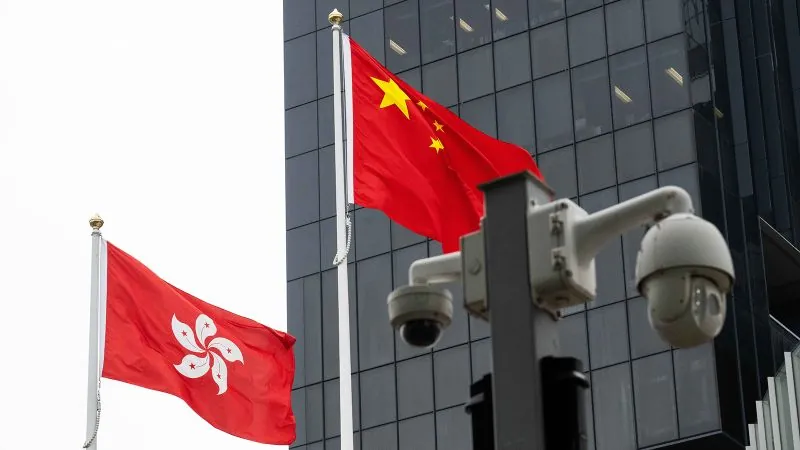
Hong Kong's Surveillance Expansion: Are We Watching a Slide Towards Authoritarianism?
2024-10-06
Author: Ming
Introduction
As you walk through the bustling streets of downtown Hong Kong, the unmistakable presence of surveillance cameras looms above – a black, glassy lens capturing the vibrancy of city life. However, this sight is set to multiply significantly in the coming years as the local police embark on a controversial plan to enhance their surveillance capacity by installing thousands of new cameras.
Security Justification versus Privacy Concerns
Despite being rated as one of the world's safest major cities, authorities argue that the cameras are essential for crime prevention. With this initiative comes the troubling prospect of facial recognition technology and artificial intelligence being integrated into the surveillance system, raising alarms among privacy advocates and experts. They warn that this step brings Hong Kong closer to the extensive surveillance practices found in mainland China, which have been criticized for their invasive and repressive nature.
Plans and Developments
The Hong Kong Police Force had initially aimed to install 2,000 additional surveillance cameras within this year alone, with plans to escalate that number in subsequent years. Security Chief Chris Tang has indicated that the intention is to incorporate powerful facial recognition features in the future, allowing AI to assist in tracking down suspects. These developments are reflective of a broader trend seen globally, where governments attempt to harness technology for law enforcement.
Socio-Political Context
However, what sets Hong Kong apart is not merely the introduction of surveillance systems but the socio-political context in which these tools are deployed. Following the wave of protests in 2019, the city has seen a strict enforcement of national security laws that have effectively stifled dissent and curtailed civil liberties. This has cultivated a profound mistrust among residents regarding government surveillance and its implications for personal freedom.
Current Surveillance Landscape
Comparatively, Hong Kong currently has around 54,500 public CCTV cameras, which translates to roughly seven cameras per 1,000 people. While this is less than London (13 per 1,000) and drastically below mainland China (around 440 per 1,000), the trajectory indicates a growing concern about the potential replication of a similar surveillance state in Hong Kong.
Historical Context of Protests
Protests against government scrutiny, particularly during the 2019 demonstrations, highlighted fears of a system reminiscent of mainland China's facial recognition technology, utilized to monitor political dissent and enforce conformity. The use of such technology has already been documented in cases of civil rights abuses, particularly in regions like Xinjiang, where it serves as a tool of oppression against the Uyghur population.
Arguments for Surveillance
Authorities argue that these cameras are necessary for crime prevention, claiming that pilot programs have already produced valuable evidence leading to arrests. Nonetheless, many experts caution that without robust regulatory frameworks, these technologies could easily morph into instruments for political control rather than public safety. The ambiguity surrounding the usage of such technologies—whether for routine law enforcement or broader social control—fuels apprehension regarding their deployment.
Ethical Considerations and Regulatory Needs
As the Hong Kong Police assert adherence to privacy laws and limited retention of footage, questions loom over the effectiveness and ethical use of AI and facial recognition. Experts are advocating for transparency, emphasizing the need for clear regulations that delineate when and how these technologies can be deployed while safeguarding citizens' rights.
Public Sentiment and Future Outlook
The overarching sentiment is palpable; as Hong Kong prepares to adopt these advanced surveillance technologies, residents are increasingly aware of the potential implications for their personal liberties. The transformation of the city into a surveillance-heavy environment may erode the public's sense of autonomy and freedom, impacting social behaviors and stifling dissent in a city that has historically prided itself on openness.
Conclusion
As we witness the evolution of surveillance technology in Hong Kong, the pressing question remains: will this mark a new chapter of oppression in the city's unique political landscape, or will it serve a legitimate purpose in enhancing public safety? The world will watch closely as this narrative continues to unfold.

 Brasil (PT)
Brasil (PT)
 Canada (EN)
Canada (EN)
 Chile (ES)
Chile (ES)
 España (ES)
España (ES)
 France (FR)
France (FR)
 Hong Kong (EN)
Hong Kong (EN)
 Italia (IT)
Italia (IT)
 日本 (JA)
日本 (JA)
 Magyarország (HU)
Magyarország (HU)
 Norge (NO)
Norge (NO)
 Polska (PL)
Polska (PL)
 Schweiz (DE)
Schweiz (DE)
 Singapore (EN)
Singapore (EN)
 Sverige (SV)
Sverige (SV)
 Suomi (FI)
Suomi (FI)
 Türkiye (TR)
Türkiye (TR)